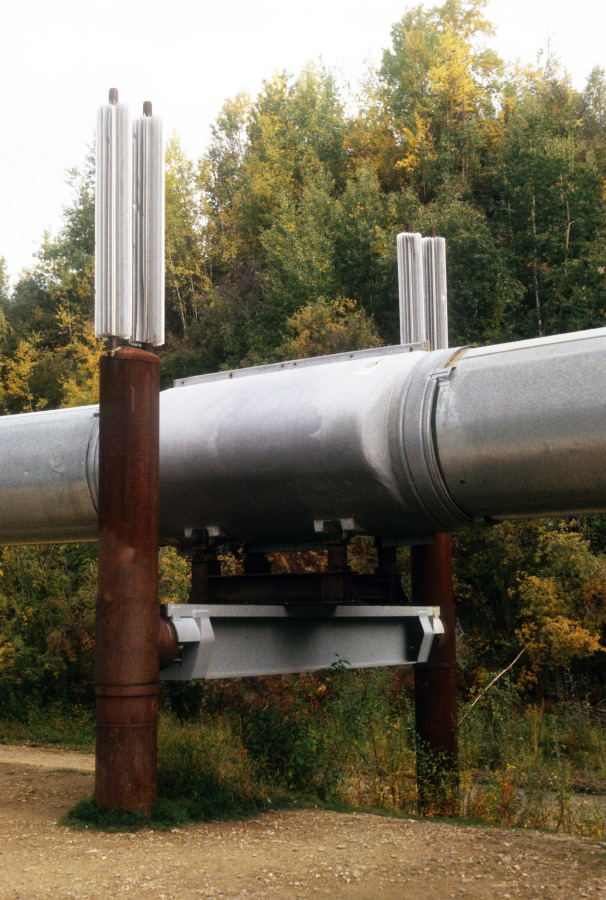
http://cdn.c.photoshelter.com/img-get/I0000EjXhqL7CBPE/s/750/750/06AK-3209-12pan-Alyeska-Pipeline.jpg
| Home |
| The Trans-Alaska
Pipeline |
| How They Work |
| Calculations &
Examples |
| Review of Design and
Effectiveness |
| Bibliography |
The
Trans-Alaska
Pipeline
System Heat
Pipes
Both of the above images show examples of heat pipes along TAPS. In the left image, brown pipes can be seen coming out the ground on each side of the silver pipeline. These brown pipes are known as vertical support members and together support the pipeline off the ground. Inside each of these VSM's is the heat pipe, which also extents out of the top. Sticking out from the VSM are two small pipes, both of which are surrounded with silver fins, acting as radiators. The rest of the heat pipe extends down the center of the VSM and bellow ground level, where it can interact with soil surrounding the VSM. In the image on the right, VSM's can also be seen extending above ground level. Here, the pipeline is buried below ground, however the importance of the heat pipes here is still crucial in keeping the ground from experiencing freeze/thaw cycles and shifting the pipeline. In fact, double the VSM's / heat pipes can be seen in the image where the pipeline is buried because the pipeline and warm oil within it now give off heat to the ground that it would otherwise radiate to the surrounding air when the pipeline runs above ground. To learn about how the heat pipes work, click here.
For an in depth look at the Alyeska Pipeline, watch the following PBS Documentary on the topic.
https://www.youtube.com/watch?v=AwdmswnwCmk
The Trans-Alaska
Pipeline System (TAPS) began construction in March of
1975 following the 1973 oil crisis as a method to
transport crude oil from America's largest oil field,
Prudhoe Bay on Alaska's north coast, to the port of
Valdez about 800 miles south. The construction was the
largest private construction project in history and
employed over 70,000 workers during construction.
According to Alyeska Pipeline Service Company, the
operator of the pipeline, almost 17 billion barrels of
crude have flowed through the pipe, with the largest
throughput in a single day occurring on January 14,
1988 with 2,145,297 barrels. The pipeline crosses a
variety of terrain, from arctic tundra, mountain
passes, major geological faults, and large rivers such
as the Yukon River. Dealing with Alaska's permafrost
was another one of the challenges in designing and
building TAPS, and the solution to this issue can be
seen today in over 124,000 heat pipes located within
the pipeline's vertical support members (VSM), 2 heat
pipes per VSM.


https://c2.staticflickr.com/6/5276/5836066599_8c60e4e18e_b.jpg
http://upload.wikimedia.org/wikipedia/commons/thumb/d/d9/Heatpipes.JPG/220px-Heatpipes.JPG
Both of the above images show examples of heat pipes along TAPS. In the left image, brown pipes can be seen coming out the ground on each side of the silver pipeline. These brown pipes are known as vertical support members and together support the pipeline off the ground. Inside each of these VSM's is the heat pipe, which also extents out of the top. Sticking out from the VSM are two small pipes, both of which are surrounded with silver fins, acting as radiators. The rest of the heat pipe extends down the center of the VSM and bellow ground level, where it can interact with soil surrounding the VSM. In the image on the right, VSM's can also be seen extending above ground level. Here, the pipeline is buried below ground, however the importance of the heat pipes here is still crucial in keeping the ground from experiencing freeze/thaw cycles and shifting the pipeline. In fact, double the VSM's / heat pipes can be seen in the image where the pipeline is buried because the pipeline and warm oil within it now give off heat to the ground that it would otherwise radiate to the surrounding air when the pipeline runs above ground. To learn about how the heat pipes work, click here.
For an in depth look at the Alyeska Pipeline, watch the following PBS Documentary on the topic.
https://www.youtube.com/watch?v=AwdmswnwCmk